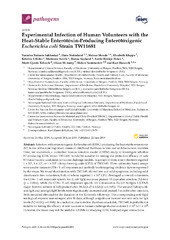| dc.contributor.author | Sakkestad, Sunniva Todnem | en_US |
| dc.contributor.author | Steinsland, Hans | en_US |
| dc.contributor.author | Skrede, Steinar | en_US |
| dc.contributor.author | Kleppa, Elisabeth | en_US |
| dc.contributor.author | Lillebø, Kristine | en_US |
| dc.contributor.author | Sævik, Marianne | en_US |
| dc.contributor.author | Søyland, Hanne | en_US |
| dc.contributor.author | Heien, Astrid Rykkje | en_US |
| dc.contributor.author | Tellevik, Marit Gjerde | en_US |
| dc.contributor.author | Barry, Eileen M. | en_US |
| dc.contributor.author | Sommerfelt, Halvor | en_US |
| dc.contributor.author | Hanevik, Kurt | en_US |
| dc.date.accessioned | 2019-12-19T13:47:25Z | |
| dc.date.available | 2019-12-19T13:47:25Z | |
| dc.date.issued | 2019-06-22 | |
| dc.Published | Sakkestad ST, Steinsland H, Skrede S, Kleppa E, Lillebø K, Sævik M, Søyland H, Heien, Tellevik MG, Barry E, Sommerfelt H, Hanevik K. Experimental Infection of Human Volunteers with the Heat-Stable Enterotoxin-Producing Enterotoxigenic Escherichia coli Strain TW11681. Pathogens. 2019;8:84 | eng |
| dc.identifier.issn | 2076-0817 | |
| dc.identifier.uri | https://hdl.handle.net/1956/21226 | |
| dc.description.abstract | Infection with enterotoxigenic Escherichia coli (ETEC) producing the heat-stable enterotoxin (ST) is one of the most important causes of childhood diarrhoea in low- and middle-income countries. Here, we undertook a controlled human infection model (CHIM) study to investigate whether ST-producing ETEC strain TW11681 would be suitable for testing the protective efficacy of new ST-based vaccine candidates in vaccine challenge models. In groups of three, nine volunteers ingested 1 × 106, 1 × 107, or 1 × 108 colony-forming units (CFU) of TW11681. Flow cytometry-based assays were used to measure CD4+ T cell responses and antibody levels targeting virulence factors expressed by the strain. We found that infection with TW11681 elicited few and mild symptoms, including mild diarrhoea in two volunteers, both of whom ingested 1 × 106 CFU. Averaged across all volunteers, the CD4+ T cell responses specific for E. coli YghJ mucinase peaked 10 days after infection (3.2-fold (p = 0.016)), while the CD4+ T cell responses specific for Colonization Factor Antigen I (CFA/I) major fimbrial subunit (CfaB) peaked after 28 days (3.6-fold (p = 0.063)). The serum CfaB-specific anti-IgA and anti-IgG/IgM levels were significantly increased and peaked 3 months after infection. Both remained elevated for the duration of the 12-month follow-up. The corresponding anti-YghJ serological response was strongest after 10 days, although a significant increase was seen only for IgA levels (3.2-fold (p = 0.008)). In conclusion, due to its low diarrhoea attack risk, TW11681 is probably not suitable for testing the efficacy of new vaccines in human challenge studies at doses 1 × 106 to 1 × 108. However, the strain may still be useful in CHIMs for studying ETEC host-pathogen interactions. | en_US |
| dc.language.iso | eng | eng |
| dc.publisher | MDPI | eng |
| dc.rights | Attribution CC BY | eng |
| dc.rights.uri | http://creativecommons.org/licenses/by/4.0 | eng |
| dc.subject | enterotoxigenic Escherichia coli | eng |
| dc.subject | diarrhoea | eng |
| dc.subject | controlled human challenge model | eng |
| dc.subject | experimental infection | eng |
| dc.subject | heat-stable enterotoxin | eng |
| dc.subject | Colonization Factor Antigen I | eng |
| dc.subject | YghJ | eng |
| dc.title | Experimental Infection of Human Volunteers with the Heat-Stable Enterotoxin-Producing Enterotoxigenic Escherichia coli Strain TW11681 | en_US |
| dc.type | Peer reviewed | |
| dc.type | Journal article | |
| dc.date.updated | 2019-08-14T12:38:22Z | |
| dc.description.version | publishedVersion | en_US |
| dc.rights.holder | Copyright 2019 The Author(s) | |
| dc.identifier.doi | https://doi.org/10.3390/pathogens8020084 | |
| dc.identifier.cristin | 1715938 | |
| dc.source.journal | Pathogens | |

